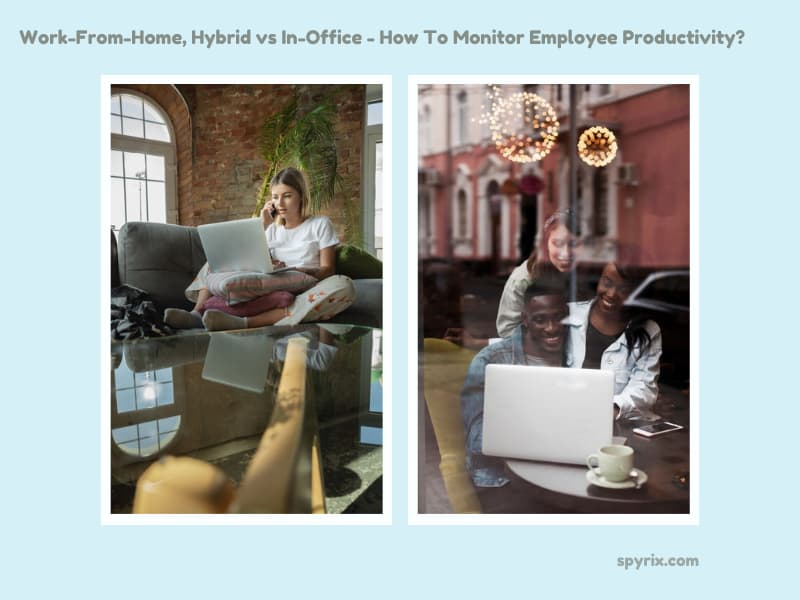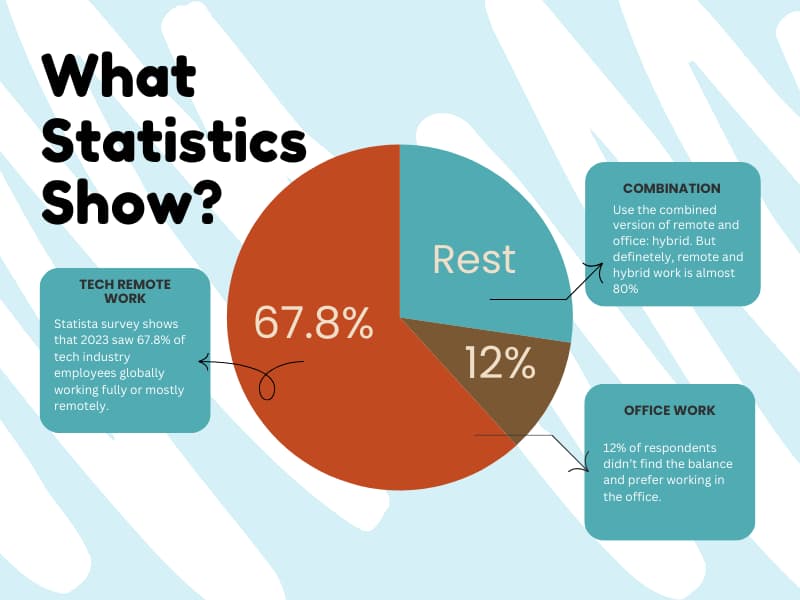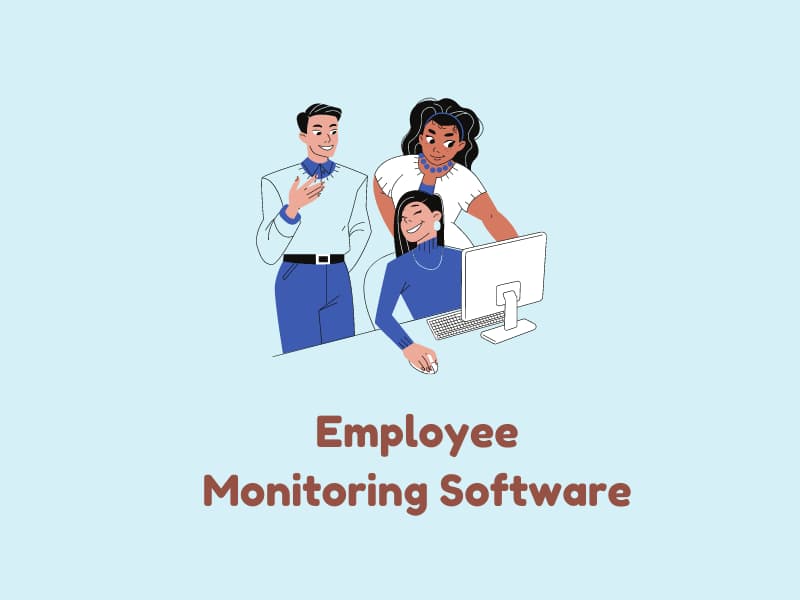Work-From-Home, Hybrid vs In-Office - How To Monitor Employee Productivity?
2024-08-27

What offers us post-pandemic high-speed developing time? We have and, already, used to “play catch up”. Working mode, as well, doesn’t stand still, being changed irreversibly because of COVID-19. Let’s get acquainted with the main innovations in today's working flow. Now, companies worldwide offer three work models: work-from-home (abb. WFH), hybrid, and in-office. We are going to look at them closely and find out about how to monitor employee productivity in this case.
Table of contents:
Basic Concepts
This section will reveal the basic concepts of the described work modes with their upsides and downsides.
What is Hybrid Work?
Hybrid work is a flexible work model, implying 40/60 operating mode: 40% of the workweek an employee is in the office, 60 - out. The number of days in the office may be bigger or lesser, it all depends on the company’s policy. The pandemic makes businessmen accept such a tendency during those reduced circumstances. There are many companies, including, for example, LHH – Lee Hecht Harrison that have used and still are using this work model. But 2023 has brought the tendency known as the Return-To-Office (abb. RTO) as executive staff has a strong belief it will raise its revenue much higher.
Hybrid work makes the executive staff monitor the productivity of each employee. They spend thousands of dollars to purchase employee monitoring software - time tracking, snapshots, screen monitoring, keylogger, and many other options.
Spiceworks survey states that only 9% of employers do not monitor employees’ activities during working hours either in or out the office.
Pros and Cons
| Aspect | Pros | Cons |
|---|---|---|
| Flexibility | Employees can choose where they work, improving work-life balance | Can result in instability in team accessibility and collaboration |
| Productivity | Enhance productivity due to a comfortable environment | Persists a risk in the productivity reduction |
| Work-life balance | Reduced commuting time and increased personal time | Blurred boundaries between work and personal life |
| Employee satisfaction | Increased job satisfaction due to greater autonomy and flexibility | The risk of disconnection from the company culture |
| Cost efficiency | Reduced overhead costs for companies (e.g., office space, utilities) | Costs associated with setting up and maintaining remote work infrastructure incl. employee monitoring software |
| Talent attraction | Access to a broader talent pool by not being limited to a specific location | Difficulty in maintaining a consistent company culture across different work environments |
| Collaboration | The use of digital tools can help arrange communication and collaboration across locations | Challenges in spontaneous collaboration and brainstorming sessions |
| Technology use | Encourages adoption of advanced technology and digital tools | Dependence on technology, which can be problematic if there are technical issues or cyber security concerns |
| Company culture | Allows for the preservation of some in-office culture while embracing modern work trends | Potential for a divided workforce where remote employees feel less connected and engaged |
| Health & safety | Lower risk of spreading illnesses with fewer people in the office at the same time | Possible challenges in managing health and safety for remote workers, including ergonomic setups |
What is WFH (Remote Working Mode)?
Work-from-home mode is a remote model at which an employee realizes all his duties out of the office. Such a model allows employees to work at home, cafe, park, or another city/country. The communication is carried out through the use of digital communication and collaboration tools. This mode of operation has gained popularity, particularly with global events such as COVID-19, times when all people have to distance themselves from each other.
Clear explanation of duties, working hours, time limits help still such a WFH mode “survive”. We should mention that each remote employee should be technically supplied, otherwise return to the office work.
Along with hybrid work, the executive staff tries to monitor employee productivity through different software options. We will get you more details below about what employee monitoring software is offered by Spyrix. This software is an efficient tool to fill the gaps in the staff productivity.
Advantages and Disadvantages
| Aspect | Advantages | Disadvantages |
|---|---|---|
| Location independence | Employees can work from any location with internet access | Potential for isolation and feelings of loneliness due to lack of face-to-face interaction |
| Cost savings | Reduces commuting, working dress, and meal costs for employees | Initial setup costs for a home office, including equipment and internet upgrades |
| Flexible schedules | Allows for flexible work hours, improving work-life balance | Blurred boundaries between work and personal life, leading to potential overwork or burnout |
| Productivity | Can lead to higher productivity with fewer office distractions | Challenges with maintaining focus due to home distractions, such as family |
| Global talent pool | Access to a wider range of talent from different geographic locations | Cultural and time zone differences can complicate communication and collaboration |
| Autonomy | Greater autonomy in managing work and time, leading to higher job satisfaction | Requires strong self-discipline and time management skills to stay productive |
| Communication | Can encourage more thoughtful and documented communication through digital tools | Risk of miscommunication due to lack of non-verbal cues and reliance on written communication |
| Cost efficiency | Employers save on office space, utilities, and on-site amenities | Possible costs for providing employees with the necessary equipment and software for remote work |
| Career advancement | Employees have the opportunity to work with diverse teams globally | Remote workers may have fewer opportunities for networking and career advancement |
| Health & safety | Lower risk of exposure to illnesses and workplace-related injuries | Ergonomic challenges and lack of proper office setups can lead to health issues, such as back pain |
| Technology dependence | Encourages the use of advanced technology and digital tools | Heavy reliance on technology, which can be problematic in case of technical failures or cyber threats |
| Work-life balance | More time for personal activities due to saved commuting time | Difficulty in “switching off” from work, leading to stress and potential burnout |
In-Office Concept of Work
In-office concept of work is a classic 9-to-5 Monday through Friday model. Every employee should be in the office during regular working hours, communicate face-to-face with other staff, and do your job.
In turn, companies should ensure that office spaces are designed to support both individual work and collaboration, with appropriate areas for meetings, quiet work, and socializing. While in-office work reduces the need for WFH technology, digital tools for communication and collaboration can still enhance productivity and flexibility. Besides, many companies use employee monitoring software to keep abreast employees’ productivity + sensitive data protection.
The in-office work remains a prevalent and effective model. Particularly it is traced for roles that require close collaboration, access to specialized resources, or a strong emphasis on company culture.
Upsides and Downsides
| Aspect | Upsides | Downsides |
|---|---|---|
| Physical presence | Facilitates real-time, face-to-face interaction and collaboration | Requires daily commuting, which can be time-consuming and stressful |
| Structured environment | Provides a controlled, structured environment that can enhance focus and productivity | Fixed schedules with less flexibility can be challenging for work-life balance |
| Immediate collaboration | Enables spontaneous discussions and quick decision-making | Office distractions, such as noise and interruptions, can reduce productivity |
| Access to resources | Direct access to office resources, equipment, and on-site support services | Limited flexibility if specialized tools or equipment are only available in the office |
| Management and supervision | Easier for managers to oversee work, provide feedback, and maintain productivity | Can lead to micromanagement or excessive oversight, reducing employee autonomy |
| Company culture | Stronger reinforcement of company culture through regular in-person interactions and team activities | Office politics and interpersonal conflicts can impact morale and work environment |
| Career advancement | More opportunities for networking, mentorship, and visibility to senior management | In-office presence may lead to bias, with remote or less visible employees being overlooked |
| Work-Life separation | Clear separation between work and home life, making it easier to disconnect after work | Commutes and long hours in the office can reduce time for personal activities and family |
| Health and safety | Standardized workstations and safety protocols can reduce risks of workplace injuries | Increased risk of spreading illnesses in shared office spaces |
| Employee engagement | On-site engagement through social events, team-building activities, and casual interactions. | Less flexibility may lead to lower job satisfaction and higher turnover for employees needing flexibility. |
What Statistics Show?
According to the statistics we’ve found, all three work modes are of high demand. Statista survey shows that 2023 saw 67.8% of tech industry employees globally working fully or mostly remotely. 50.6% of the agencies and consulting industry and 48.7% of the finance and insurance industry work remotely, respectively. These three industries took the first three places in 2023.

The research data confirmed by Office for National Statistics, February 2022 recorded 84% employees worldwide that prefer hybrid work mode. Consequently, the rate of hybrid employees (home+office) has been rising up. As mentioned, there predicted an increase in the employees’ income, which plays a major role, as well.
In the context of work-life balance, Katherine Haan at Advisor Forbes stated 71% of remote workers successfully maintain work-life balance. 12% of respondents didn’t find the balance and prefer working in the office. It became an evidence that remote and hybrid mode didn’t suit everyone.
When discussing work-from-home (100% remote mode), the theory of a new phenomenon known as “Return-To-Office (RTO)” is backed. Such mega-companies as Google, Amazon, Apple released a 2024 mandate that oblige remote employees to return to the office for at least 3 days a week. When X (former Twitter) forced employees to be in the office for the whole working week. These stats are official and provided by Statista.
Microsoft, a mega-enterprise in IT technologies and advancements, has conducted research in 2022 and stated it was rather difficult to put up with the shift to hybrid work. 85% of leaders say it was challenging to have confidence that employees are being productive.
As a result, the era of employee monitoring software has come. The niche is now overwhelmed with many programs and functions to be in closer touch with remote and hybrid employees. Above we mention that only 9% of companies don’t monitor their staff. Again Forbes Advisor shows that 37% of remote employees report that their employers monitor their online activity.
The next section will tell in detail what is an employee monitoring software.
How to Monitor Employee Productivity with WFH, Hybrid, and In-Office Mode?
Employees, in general, show different productivity rates. Someone is slower, when others - like “clockwork’s toys” - never stop. How can executive staff bear in mind all these characteristics? For these purposes employee monitoring software has been created.

What Is Employee Monitoring Software?
Employee monitoring software is a kit of tools that makes it possible to collect, record, and analyze data received from any computer in your office. The software monitors the target computer only within the regular working hours.
An executive staff may install an employee monitoring agent to any computer. This software can collect data on various aspects of employee behavior, including time spent on tasks, internet usage, application usage, keystrokes, email communications, and even screen activity. The primary purpose of employee monitoring software is to ensure productivity, maintain security, and optimize workflow management within a company.
Types of Employee Monitoring Software
There are the following types of employee monitoring software:
- keylogging
- screenshot capture activities in applications
- social networks and messengers (Skype, Slack, Facebook Messenger, Whatsapp etc.)
- online activities
- live screen viewing
- continuous screen recording
- call recordings
- recording from web camera
- removable drivers control
These are the main types that help enhance employee effectiveness at work. Read more about each type of monitoring.
How Does It Work?
The operation mode of employee monitoring software is not complicated. It includes several steps such as installation, data collection, and analysis, and reporting.
The software is installed on the target company-owned devices. If you are a remote employee, BYOD (Bring Your Own Device) scenario is used. It means employees have to install software on their personal devices with appropriate permissions.
After having installed the software, employee monitoring is conducted. It collects the following data:
- Keystroke logging: Records all keystrokes to monitor what is being typed
- Internet usage: Tracks websites visited and time spent on each site
- Email monitoring: Logs all email activity, including sent and received emails
- Application usage: Monitors which applications are used and for how long
- File access: Tracks access to files and documents within the network
- Screen recording: Captures periodic screenshots or continuous screen recordings to visualize activity
The next step is to analyze the received data. It helps understand and assess the employees’ productivity and effectiveness. This analysis can help identify patterns such as productivity peaks, frequent distractions, or unauthorized activities.
The described software is able to create reports based on the received data. It allows you to see the whole picture of what and how the working time is used. Reports might include metrics like total hours worked, activity levels, compliance with assigned tasks, and more.
The reported information should be used to correct the working process in order to get the productivity rate as high as possible.
What Benefits It Brings?
As speaking about the benefits employee monitoring software brings, we should definitely highlight:
- Increased productivity
- Enhanced employee engagement in the working process
- Optimization of the business processes
- Data security
- Project management
- Reduced risk of sensible data leakage
Of course, there are many other benefits to applying such monitoring systems, but we pick the most favorable ones.
Is The Use Of This Software Justified?
The use of this software is justified when it adheres to legal regulations. For example, almost all US states permit employee monitoring software. But there is one essential note - many countries require the employees’ awareness that they are monitored, otherwise failure to do so may lead to legal penalties or employee litigation.
Moreover, the use of monitoring software must be justified by a legitimate business need. Employers are advised to clearly define the scope and purpose of monitoring to avoid any practices that could be deemed invasive or irrelevant to business needs. For example, monitoring might be justified for providing a high rate of productivity, protecting the company’s sensitive and securing data, but not for personal or intrusive insights into an employee's private life.
Top Companies with Remote & Hybrid Work Mode
The pandemic time contributes to the development of new work modes: remote and hybrid. Post-pandemic times do not see 100% return-to-office tendency. We’ve collected the list with top global companies in order to see what work mode they rely on:
Top 10 Companies for Remote Jobs:
- CVS Health
- Brightside Health
- Intuit
- Microsoft
- IBM
- Atlassian
- Indeed
- BCD Travel
- Aston Carter
- Boeing
Top Companies for Hybrid Jobs:
- Robert Half International
- Kelly
- LHH – Lee Hecht Harrison
- Creative Financial Staffing – CFS
- Randstad
- New York Life
- Allied Irish Bank – AIB
- Lincoln Financial Group
- Aston Carter
- Elevance Health
To see the full list with top 100 companies working remotely/hybrid: FlexJobs top 100 hybrid.
The 2023-2024 Tendency "The-Return-To-Office" - Success or Failure
The-Return-To-Office tendency has appeared after Covid restrictions softened considerably in 2023. But, in accordance with the survey of Inc - about 6 in 10 employees still prefer hybrid work.
Many employees working remotely and hybrid state: “They should be motivated to return to the office”. In turn, executive staff should think critically about how to lure employees back.
According to the Robin report, when asked what would make employees come into the office more, the top two incentives were office perks (44%), like catered lunch or on-site services, and coverage of commuter costs (39%). Top reasons why people still prefer remote and hybrid work are:
- Commute is too long 41%
- Gas prices are too high 32%
- Parking is too expensive 20%
But the question is still open - what employers are ready to do to motivate employees to return back to the office?
Conclusion: What Work Mode to Choose - Work-From-Home, Hybrid vs In-Office
Summing up all the text above, both work-from-home and hybrid modes of work tend to be the most popular. Even the mandate “remote-to-the-office” is not an obligatory condition for employees. But 28% of employers will threaten to fire employees for not complying with the RTO by 2024, according to the Resume Builder 2023 survey.
As a result, many global companies still offer remote (WFH) and hybrid work modes. In turn, employees strive to reduce commute extra costs. If they are motivated to have even some rate compensation, they will think over the return. Anyway, the work mode has changed forever and both employers and employees have to follow these new tendencies.
Such fast developing times push the technologies up, as well. Employee monitoring software is a way out to enhance remote, hybrid, and even, in-office workers’ productivity. This is the way to get records with already analyzed data in order to handle issues concerning productivity, security. The described software is used for business purposes only, that's why it is time to be in touch with new developments to get high-productive staff.
